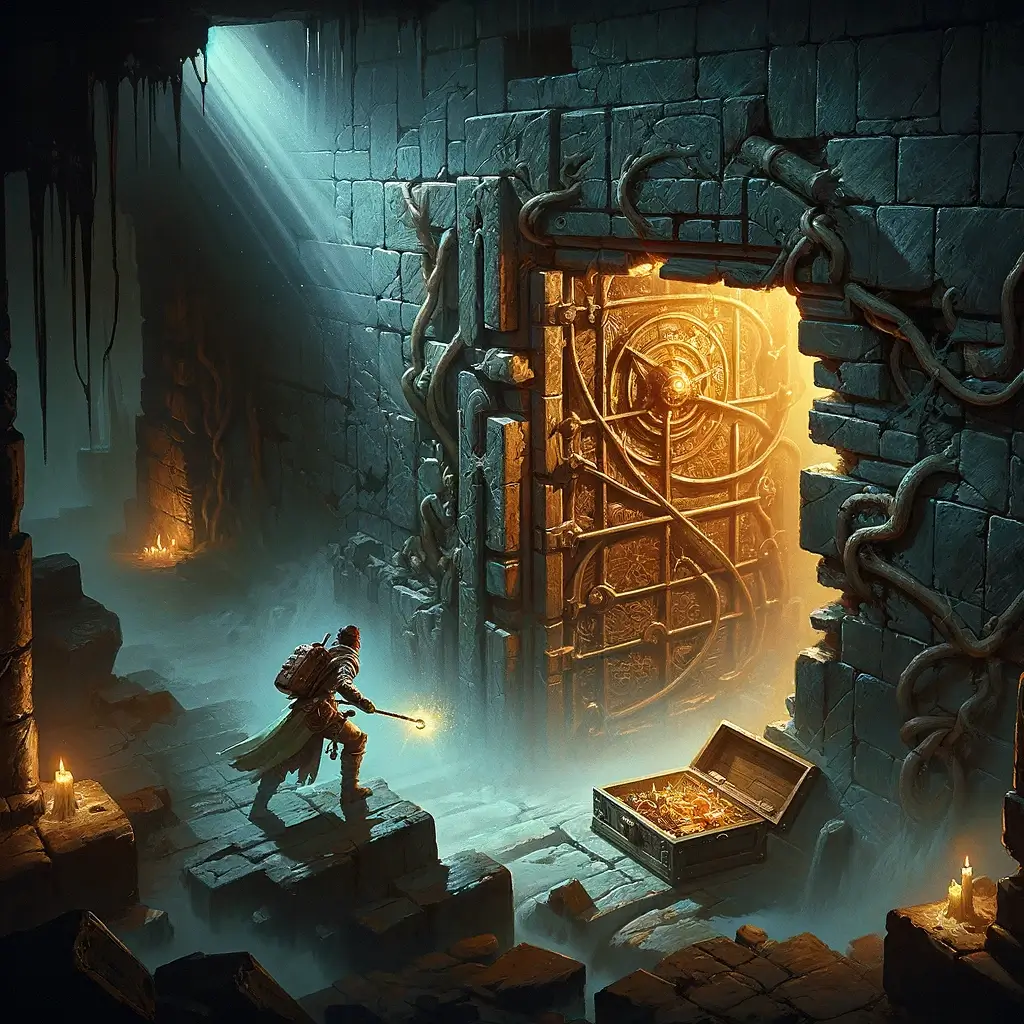As a Dungeon Master, you are the weaver of tales, the architect of perilous dungeons, and the master of secrets. The most thrilling adventures often involve a delicious sense of the unknown, the thrill of the hidden. Whether it’s a concealed chamber brimming with treasure or a subtle clue pointing to the villain’s true motives, hidden elements add depth and excitement to your D&D campaigns.
Let’s explore some ways to bring the hidden into your games:
Tangible Secrets
- Hidden Rooms and Passages: A classic! A crumbling wall concealing a relic, a hidden switch opening a secret chamber – these elements make players feel like intrepid explorers. Remember to provide subtle clues for players to discover these passages, whether it’s a draft of cold air or loose stones.
- Secret Maps and Documents: An ancient map found in a forgotten chest could lead to lost treasure, while a coded letter might reveal a plot twist. Consider using ciphers or riddles to make the discovery more challenging and rewarding.
- Illusionary Objects and Terrain: What seems like a solid wall could be an illusion concealing a passage. A seemingly ordinary object might be a hidden key or even a creature in disguise!
- Hidden Compartments: A seemingly innocuous statue could have a concealed compartment containing a priceless gem. A dusty old book on a shelf might have hollowed-out pages hiding a key or a cryptic message. Furniture, paintings, and even mundane objects can hold intriguing secrets.
- False Bottoms: A treasure chest might appear laden with riches, but a clever false bottom could conceal the real prize. A seemingly shallow pool in a dungeon might hide an underwater passage only accessible by those who dare to investigate its depths.
- Mimics at Play: The chest guarding a trove of gold is, in fact, a cunning Mimic lying in wait for unsuspecting adventurers. A door might appear to be carved of wood, but in truth, it’s a Roper cleverly disguised. Mimics and other shape-shifting creatures cleverly concealed among typical objects ramp up the excitement and keep players on their toes.
The Intrigue of the Unseen
- Hidden Motives: Not every NPC is what they seem. A helpful guide might have a secret agenda, or a fearsome monster might reveal a vulnerable side the party can exploit. Consider layers of motivation behind your characters.
- Mysterious Lore: The history of your world is a treasure trove of hidden stories. Ancient prophecies, lost civilizations, and forgotten magical artifacts can pique your players’ curiosity and fuel quests. Scatter this lore through forgotten texts and cryptic whispers.
- Hidden Factions: Perhaps a secret society pulls strings behind the scenes, influencing events the players witness. Unmasking them can become a thrilling arc in your campaign.
- Whispers from Beyond: Dreams and visions can provide tantalizing glimpses into unseen events. Perhaps a character receives prophetic nightmares hinting at a looming disaster. Maybe mysterious spirits contact a character, offering cryptic advice and fragmented knowledge about hidden threats.
- The Power of Rumors: Overheard conversations, tavern gossip, and half-truths can set your players on a trail of uncovering secrets. They might hear tales of a forgotten shrine deep within a haunted forest or whispers of a corrupt noble with ties to a dark cult. Rumors can be misleading but can also provide crucial leads.
- Unexplained Phenomena: Strange, seemingly unnatural occurrences can hint at hidden forces at work. Animals might behave oddly in a particular area, hinting at a magical disturbance. A sudden, localized change in weather could signal a ritual being performed in secret. This kind of unexplained mystery can spark curiosity and a deeper investigation by your players.
Tips for Effective Reveals
- Subtlety is Key: Avoid direct handouts. Guide your players by using hints, like strange symbols, unusual behavior, or seemingly irrelevant side quests.
- Build Anticipation: Drop clues gradually over multiple sessions. The longer players work towards a discovery, the more satisfying the reveal.
- Reward Investigation: Encourage players to investigate their surroundings and ask questions by providing them with tangible rewards for their curiosity.
- Don’t Overdo It: Too many hidden elements can dilute the sense of discovery. Keep them impactful and well-spaced within your narrative.
Example: The Whispering Idol
The party investigates reports of strange occurrences in an old temple. A seemingly ordinary idol whispers cryptic prophecies with seemingly no origin. After investigation, they discover the idol is hollow, housing a trapped spirit seeking a way to be freed. The party’s choices in interacting with the spirit have far-reaching consequences for their campaign world.
Mechanic Considerations
- Skill Checks:
- Perception: Perfect for noticing subtle details like a hidden door mechanism, disturbed dust suggesting a secret passageway, or out-of-place items in a room.
- Investigation: Essential for actively searching, deciphering cryptic markings, recognizing patterns in seemingly unrelated objects, or scrutinizing an item for hidden compartments.
- Arcana: Crucial for understanding magical runes, wards triggered by arcane gestures, or the history behind a relic linked to lost magical practices.
- Others: Don’t neglect skills like History (for lore that hints at hidden elements), Religion (for deciphering a holy site’s secrets), or even Deception (to detect someone intentionally misleading the party).
- Consequences of Failure: Don’t let failed rolls mean nothing happens. Consider:
- Misdirection: A failed Perception check on a hidden door might lead them to notice a shiny but ultimately useless trinket.
- Partial Information: Success might reveal the presence of a hidden element, while a higher Difficulty Class (DC) reveals details about its nature.
- False Positives: A nervous character fails an Investigation check and thinks they’ve found a secret compartment, but it’s a simple flaw in the stone.
- Complications: Triggering a trap, unknowingly alerting an enemy, or a missed detail that comes back to haunt them later.
- Difficulty & Pacing:
- Start Easy: Early on, use simpler skill checks and more overt clues to get players in the habit of looking for hidden elements.
- Scale with Experience: Over time, ratchet up the difficulty and subtlety. Hidden compartments in furniture might be a DC12 Investigation, while cryptic runes could be DC15+.
- Mix and Match: Balance difficult discoveries with some easy finds to maintain player engagement.
- Session Pacing: Don’t pack every scene with secrets. Leave room for other interactions, or the search for the hidden may get tiresome.
DM Guidance
- Planting Clues:
- Sensory Details: Describe the musty smell of old parchment near a bookcase, the unusual echo in a chamber, uneven wear on a specific floor tile.
- NPC Behavior: A shifty-eyed innkeeper, someone glancing over their shoulder, a hushed conversation cut short as the party enters.
- Reoccurring Symbols: A symbol appears in a seemingly unrelated place, piquing curiosity before finally being linked to the main hidden element.
- Physical Objects: Forgotten notes, damaged maps, or a peculiar key found on a defeated enemy.
- Red Herrings:
- Planted Rumors: False stories spread by a villain to send players on a wild goose chase, wasting their time and resources.
- Deceptive Appearances: A gleaming chest turns out to be a Mimic, or what seems a helpful vision leads them deeper into danger.
- Ordinary with a Twist: A dusty book everyone assumes is mundane actually holds a vital clue, but ONLY read under moonlight.
The hidden element is the key to both engaging your players and creating memorable adventures. Embrace the unseen, let your players uncover tantalizing secrets, and guide them on a journey filled with wonder and surprise!



































